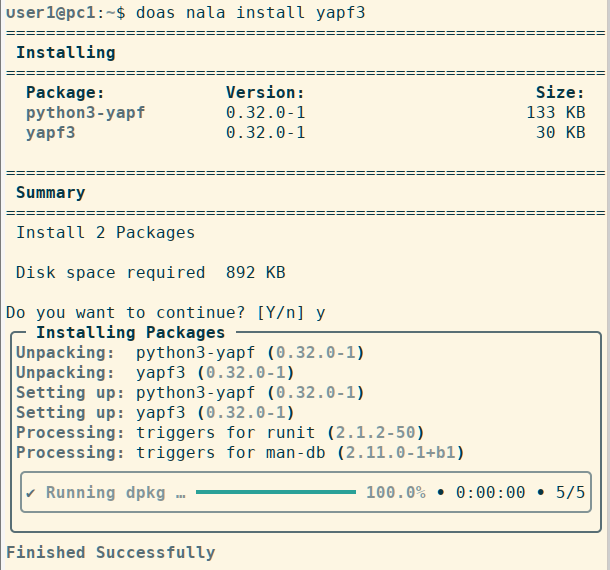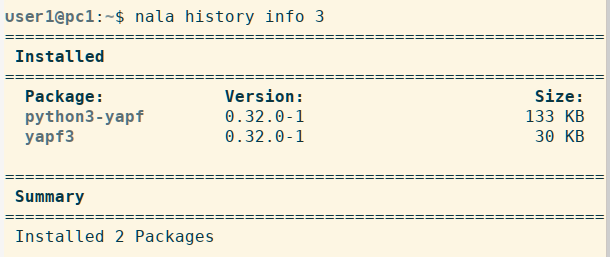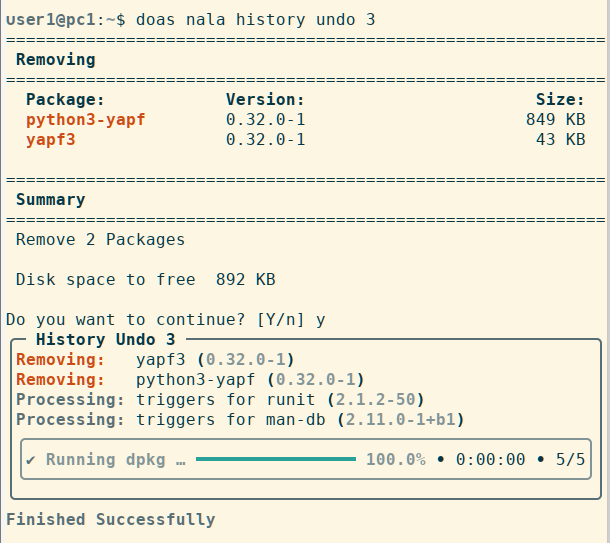
More user-friendly and powerful than APT
Nala is a command line frontend for the APT package manager. It uses
the python-apt API instead of the APT libraries to manage
packages. The goal of Nala is to provide a clearer and more
user-friendly display of the current package inventory as well as the
requested actions and their execution. It also intends to speed up
package download.
Nala uses many APT commands such as install,
remove, purge, update,
show, and search. It also implements the
history command to see past transactions and allow the user
to undo them, and the fetch command that displays a list of
the fastest mirror servers to choose from. By default, Nala speeds up
downloads by fetching three packets at a time from a server. The limit
of three connections per mirror exists to minimize the load on the
mirrors.
As of siduction 2022.1.0, Nala is installed automatically and can be
used immediately. It is not mandatory to use Nala, you can switch
between APT and Nala at will. A look at the manpage
man nala should be mandatory. Before using
it, we strongly recommend making two changes in the configuration file
/etc/nala/nala.conf.
First, we change the value for the auto_remove
configuration option to false as shown in the following
listing:
# Set to false to disable auto auto-removing
auto_remove = falseSecondly, the value full_upgrade = false, this must be
changed to true to automatically perform a
full-upgrade.
# Set to true to make full-upgrade the default
full_upgrade = trueThe reason for both changes is that siduction is based on GNU
Linux debian unstable/sid and this base changes daily and therefore
needs to be updated regularly. When upgrading from debian sid,
occasionally a situation may arise where significant parts of the system
should be removed. With the option auto_remove = true we
have no way to research, check and decide for ourselves if or which
packages to remove. Even in normal operation packages should not be
removed with auto_remove, but only after a visual
check.
If in an exceptional case it is necessary to upgrade the
system without a full-upgrade, nala can be
called with the following command,
nala upgrade --no-full.
Many of the commands known from APT are identical in Nala. By default, Nala always expects confirmation before performing a requested action that changes the system.
nala update
Updates the package information of the configured package
sources.
nala install <package>
Installs the named package into our system.
nala remove <package>
Removes the named package from our system.
nala purge <package> or
nala remove --purge <package>
Removes the named package with its configuration files from our
system.
nala upgrade
Runs update followed by upgrade. (default
setting in /etc/nala/nala.conf file)
Runs update followed by upgrade --full. (With
the above changes in the file /etc/nala/nala.conf)
The user-friendly formatting of the output in the terminal
facilitates the overview, as the example shows.
(To gain root privileges, “doas” was used in the command.)

In the first part of the output we get a list of the packages to be installed with the indication of their versions and size. After confirmation, the second part lists the actions performed.
“fetch” command
The nala fetch command, run without any
other options, automatically determines the distribution and release of
our installation, searches for the fastest mirror servers, lists them
for interactive selection, and, after selecting one or more servers,
creates the file
/etc/apt/sources.list.d/nala-sources.list.
The -c, --country option limits the search using the ISO
country code. Multiple specifications of the option are allowed.
The --non-free option adds contrib and non-free components
to the file.
During download, up to three packages are fetched from the server simultaneously.
“history” command
The nala history command, called
without a subcommand, shows a summary of all actions performed with
Nala. Each line corresponds to an action and contains the ID, the
command, the timestamp, the number of packages changed, and the user who
requested the action. Actions performed by other programs are not
recorded.

Details about an action from the history are shown by the same
command with the attached subcommand info <ID>.

If we now want to undo the installation of “yapf3” with its
dependencies, in our case “python3-yapf”, we use the subcommand
undo <ID> for this.
(Again, user1 gets root privileges by using
“doas”.)

In the first part of the output, we see the packages to be removed
with the indication of their versions and size. After confirmation, the
second part lists the actions performed.
If we change our mind and want to use the packages again, the
nala history redo <ID> command will help us to
perform the action again. The nala history clear <ID>
command can be used to remove entries from the history,
nala history clear --all removes all entries.
In the Nala version 0.11.1 described here, the subcommands
undo <ID> and redo <ID> currently
only support the actions Install or Remove. In a future version, which
will be based on the Rust programming language, it should be possible to
roll back complete dist upgrades.